Type XB, the minelayer U-Boats
 Germany (1939-45): U-116, U-117, U-118, U-119, U-219, U-220, U-233, U-234
Germany (1939-45): U-116, U-117, U-118, U-119, U-219, U-220, U-233, U-234
WW2 U-Boats:
Seeteufel (1944) | Type Ia U-Boats (1936) | Type II U-Boats (1935) | Type IX U-Boats (1936) | Type VII U-Boats (1933) | Type XB U-Boats (1941) | Type XIV U-Boats (1941) | Type XVII U-Boats (1944) | Type XXI U-Boats (1944) | Type XXIII U-Boats (1944) | German mini-subs and human torpedoesThe Type X (XB) U-boats were a special type of German submarines of WW2 originally designed as long-range minelayers, but later used as long-range cargo transports as the Type IXD U-Boats, Italian Romolo-class submarines and several Japanese Types. In all, only eight were built, consistent for this complex and costly type compared to other nations. Six on the eight boats, the largest U-Boats of WW2, were lost: U-116 in October 1942, North Atlantic, U-117 in August 1943 by USS Card, U-118 on 12 June 1943 by USS Bogue, U-119 on 24 June 1943 by HMS Starling, U-220 on 28 October 1943 by USS Block Island and U-233 on 5 July 1944 by USS Baker and USS Thomas.
Design Development
Background
Previous German experience
Minelayer submarines seemed very seducive to many admiralties before even WWI, when this new boat was barely taken seriously as a weapon, still. The Germans developed at first two classes, the ten U71 class (1915), which carried thirty-four 100cm (3.2ft or 39 in) mines in horizontal stern tubes, and the eight U117 (1917) which carried 42 in tubes and 30 on deck stowage. Later an entire line of specialized coastal minelayers, called the UC types: UC1 (launched 1915), UC16 (launched 1916-18), UC80 (1918, most never completed).
Moderate International Adoption
Many were passed on the entent powers as war reparation in 1919-1920 and tested. Soon, several were built, and the allies had at least an operational class when WW2 broke out, such as the British Grampus class and the French Saphir class, the US had the single USS Argonaut (1927), the IJN developed the KRS class in 1926, Italy operated the Bragadin class (1929) and Pietro Micca (1935) and the Soviet Union the series XI, XIII/XIIIbis and XIV. These were not very common types overall compared to standard coastal and oceanic types.
German Reboot: The Batiray

During the interwar the German Navy was forbidden by the Versailles treaty to have any submarines. The development of a design office in the Netherlands, Ingenieurskantoor voor Scheepsbouw to keep the skills sharp in the 1920s helped at least to continue working on improved types, but based always on foreign orders and specifications. There was no minelayer type until the Turkish Batiray (1938), a 1044 tons (surfaced) type capable of carrying 40 mines, built at Germaniawerft and launched in August 1939, but taken over by the German Navy after completion. She made her sea trials under her original Trurkish name, but was thus never delivered to Turkey and instead renamed UA, kept for experimentations with the type.
But as the war broke out she was quickly operational, counting on her six torpedo tubes and long range. Under command of Kapitänleutnant Hans COHAUSZ, U-A made two sorties from Sept 17, 1939 to Oct 31, 1940, with 92 days at sea for 7 victories. By late 1940 to early 1941 she conducted an attack on convoy OB 293. We are not going to dive deep into her career, but in between standard patrols she also was used as a cargo, and ended scuttled in Kiel in May 1945. No doubt that her design could be considered as a prototype for the Type X class, although in between the ordnance came with a new type of mine and specifications changed. She will be covered in her own post soon.
Early specifications and development of the Type X (XA)
The Type X was originally designed specifically to accommodate the newly developed Schachtmine A (SMA) moored mine. The initial specification asked to provide dry storage for these mines, which needed their detonators to be individually adjusted before launch by the crew. This designed was established in the design bureau of the Marinewerftabteilung, in coordination with the Marinewaffenamt (MWa) for the mines and their tubes, and the Marinekonstruktionsamt (K) which setup the requirements.
The final submarine was projected to have a 2,500 tonnes displacement, surfaced. As work progressed, it was envisioned a further variant, the Type XA which was to be fitted with extra mine shafts in the saddle tanks, but they were never ordered as war priority changed.
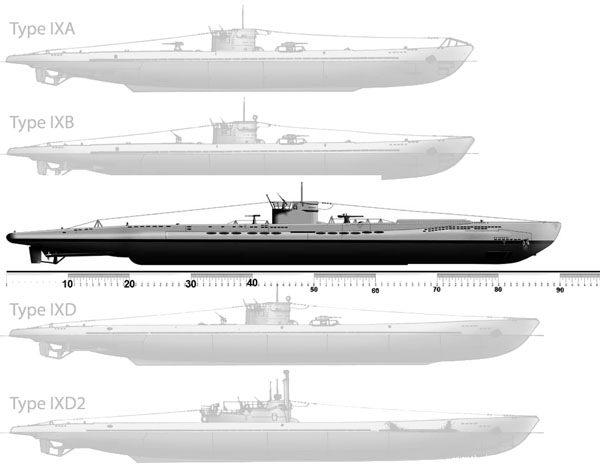
Comparison between the Type XB and Type IX variants
XB U-Boats were experimental submarines developed before the war were larger and more powerful than other U-Boats to enable long distance operations, and remaining submerged for extended periods of time thanks to a large battery capacity. Thus, they were in theory able to mine the Canadian and US east coast among others. However as priorities shifted, they were soon swapped from roles, as supply vessels for German submarines operating in the Atlantic Ocean with fuel, torpedoes, and other essential supplies as the Type XIV, or more commonly to transport valuable assets to distant ports, like Japan.
The final design settled on the XB type, which was around 200 feet (60 meters) long and had a displacement of 1,600 tons when surfaced, and 2,000 tons when submerged. They were powered by diesel-electric engines and had a top speed of around 16 knots when surfaced and 9 knots when submerged. The crew complement was around 50 men.
Construction
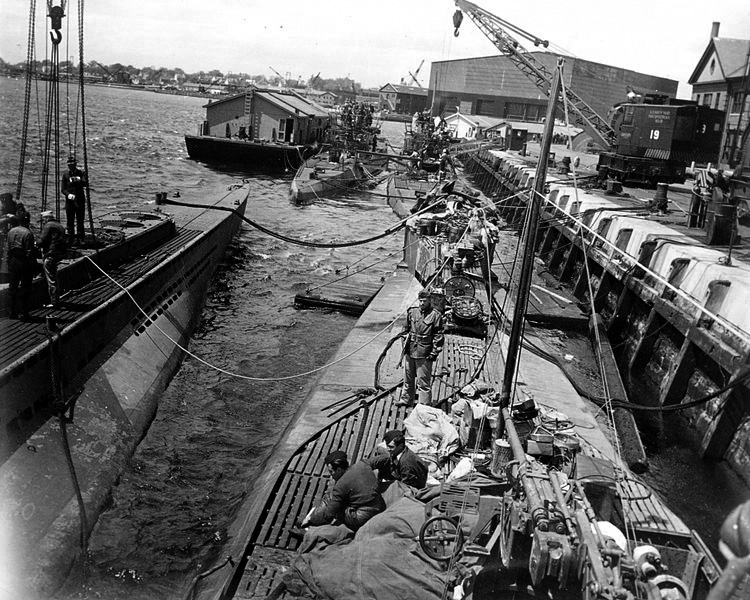
Surrendered U-Boats in portsmouth, 1945
A total of eight Type XB boats were produced, which replaced the initial mine chamber of the previous Type XA with six vertical wet storage shafts in the forward section of the hull. They were all built at F. Krupp Germaniawerft, Kiel, in three batches from 1941 to 1944:
Design of the class
Hull and general design
(plans are in search mode).
The U-Boat 1,763 tonnes (1,735 long tons) surfaced, 2,177 tonnes (2,143 long tons) submerged. They were the longest of all active U-Boats of the Kriegsmarine, at 89.80 m (294 ft 7 in) o/a long, for 70.90 m (232 ft 7 in) for the pressure hull with a beam of 9.20 m (30 ft 2 in) o/a. The internal pressure hull had a diameter of 4.75 m (15 ft 7 in) pressure hull. The type was 10.20 m (33 ft 6 in) tall up to the conning tower’s top, periscopes down in their wells. The Draught was 4.71 m (15 ft 5 in), which gave them an elongated silhouette, especially compared to the Type XIV. The crew comprised 5 officers, and 47 enlisted sailors. Compartimentation was the same as the Type XI with the exception of a forward compartment without torpedo tube chamber and instead a serie of axial mine wells. The mine wells were many. The taller axial six vertical wells forward carried three each, for 18 mines, added the the with additional 48 mines in 12 shafts (2 each) set into the saddle tanks, either side, for a grand total of thirty mine wells, carrying overall 66 mines.
The tradeoff was the elimination of froward torpedo tubes and keeping only two stern torpedo tubes for defence. When used as cargoes drum-like freight containers had been created for this class, so they they could be carried in the 30 mine shafts, or had these freight containers welded on top of the lateral shafts, making the conversion final.
Powerplant
The powerplant comprised two supercharged Germaniawerft F46 A9, 9-cylinder, four-stroke diesel engines, 4,800 PS (4,700 bhp; 3,500 kW) for surface running. This was completed by two AEG GU 720/8-287 electric motors for underwater running, the latter rated for 1,100 PS (1,100 shp; 810 kW). Top speed surfaced was ranging between 16.4 and 17 knots surfaced, for 7 knots underwater, which was “in the norm” at the time. They did not have to charge through convoys at night. Of course these performances degraded when used as cargoes, with well stuffed payload drums (like gasoline)…
Images and full doc (in spanish) – Start and sound video
Range: 18,450 nautical miles (34,170 km; 21,230 mi) at 10 knots (19 km/h; 12 mph) surfaced and 93 nmi (172 km; 107 mi) at 4 knots (7.4 km/h; 4.6 mph) submerged. They carried 338 tons of diesel oil.
Test depth was calculated at a crush depth at 220 m (720 ft). Safety operational depht was 100 mm (330 ft). But robust construction meant they could in theory dive probably down to 230 m in extreme urge. At 2,710 tonnes submerged, fully loaded, they were the largest German U-boats ever built, but translated into poor agility and long diving time.
Armament
It varied by boat and over time: The first boats were delivered with a single 105/42 SK C/32 aft deck gun, one 37mm/80 SK C/30 and one 20/65 C/38 on both CT platforms, and the two aft 533 TT stern and 66 mines. U233 and 234 had the deck gun removed and instead had a 37mm/69 FlaK M/42, and two twin 20mm/65 C/38 AA guns, and same.
Torpedo Tubes
The two stern 53.3 cm (21 in) torpedo tubes had 15 torpedoes in reserve. The torpedoes fired, by default of a better information, are assumed to the the standard G7A.
Weight 1538 kg, 280 kg warhead, 300 g Pentrite detonator, can impact to 16 degrees. Top speed 30/40/44 knots settings at 1–12 to 1–15 m underwater and respective range of 12000/7500/5000m. Powered by a 4-cylinder steam engine running on Decaline (110/350 Hp depenbding of the setting) and 1170/1280/ rpm. Using a contrarotative (six-blades total) propeller.
Deck Gun
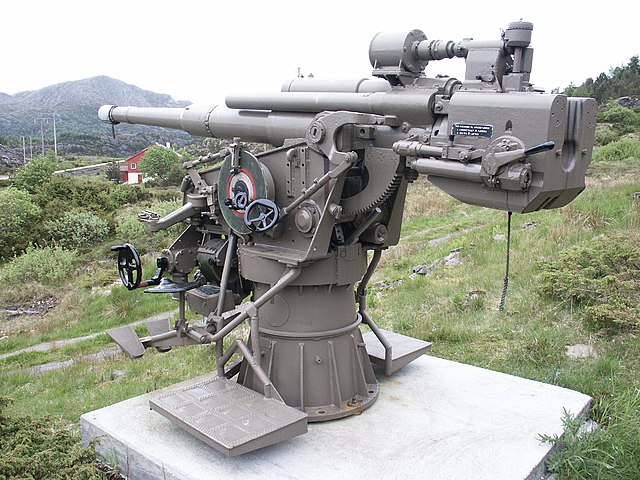
Initial boats had a single 10.5 cm (4.1 in) deck gun (200 rounds) located aft of the conning tower. This standard gun was developed from 1941 and soon became the standard German U-boat deck gun throughout the war. It fired a fixed 15.1 kilograms (33 lb) HE round with an elevation for the LC/32 mount of -10 to +35. Muzzle velocity was 785 m/s (2,580 ft/s) and max range 15 kilometers but rather 10 km useful (11,000 yd).
AA
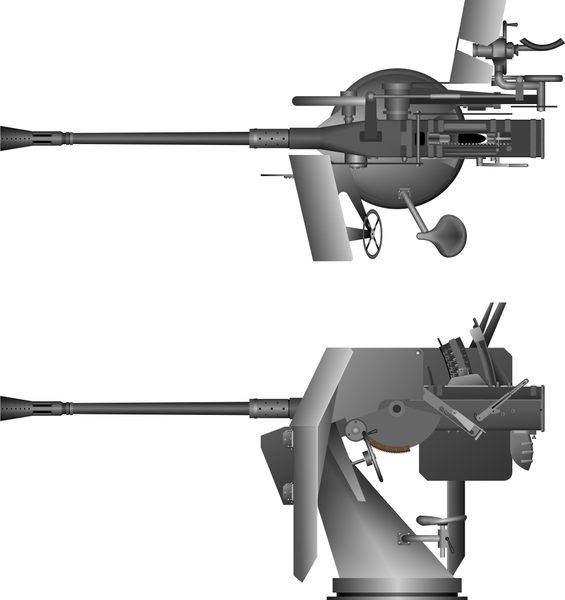
37mm/39 FLAK M/42, U-Boat mount type.
37mm/80 SK C/30: Single-shot semi-automatic breech, vertical sliding-block 30 rpm mv 1,000 m/s (3,300 ft/s) range 2,000 m (6,600 ft)/8,500 m (9,300 yd) 37.5°
37mm/39 FLAK M42: Recoil-operated sliding breech block 250 rpm cyclic (5-round clips) mv 865 m/s (2,840 ft/s) range 4,800 m (5,200 yd)@85°,6,400 m (7,000 yd)@45°
20mm/65 FLAK C/38: 450 rpm cyclic 180 rpm (20 rds mag.) mv 900 m/s (2,953 ft/s) 2,200 m (2,406 yds) ceiling
The surviving boats in 1944 had their conning tower to be ported on the second batch as standard: 37mm/69 FlaK M/42, and two twin 20mm/65 C/38 AA guns, on a two-staged conning tower aft platform arrangement inaugurated in 1943 by the “U-FLAK” modified Type VIIC.
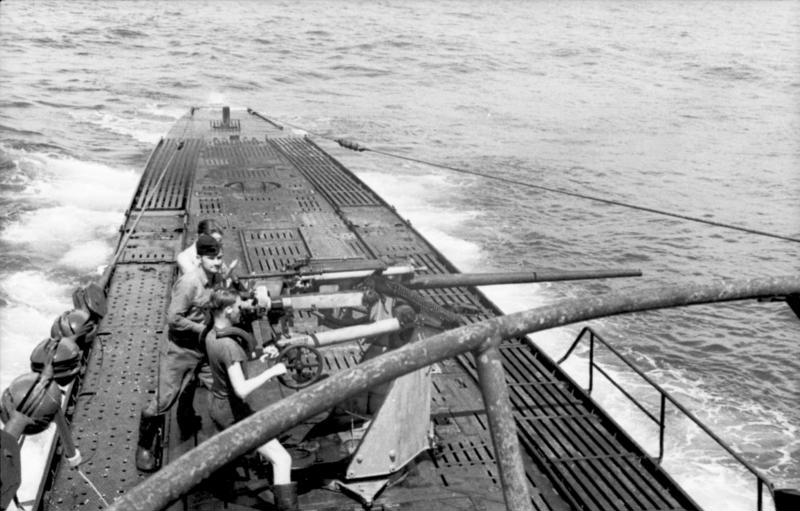
37mm/80 SK C/30 on a Type IX (Bundesarchiv)
Mines: Schachtmine A (SMA) moored type
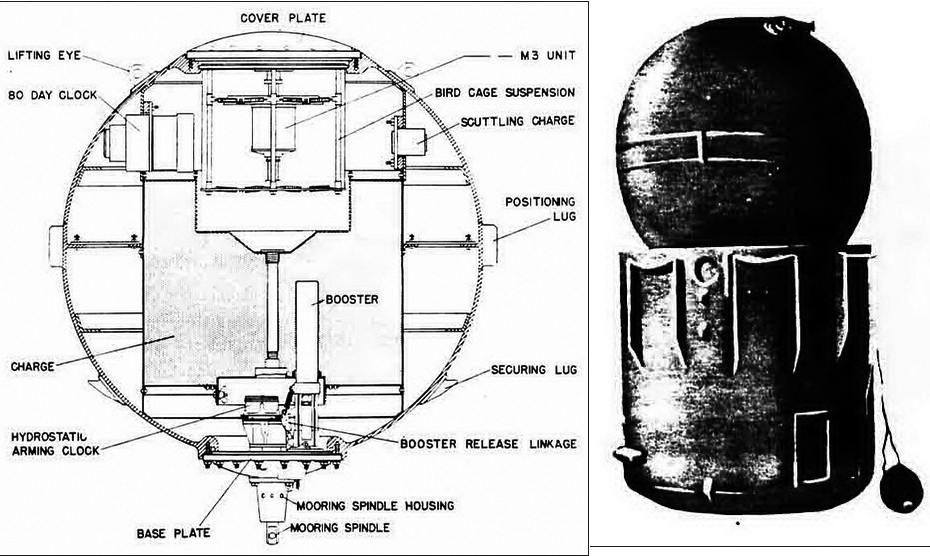
66 × SMA mines. The SMA is a moored mine similar to the TMA but with a much larger explosive charge. It was tailored to be dropped from vertical shafts, so balically for the Type XB and VIID.
Length/Diameter: 7.1ft (2.15m)/4.4ft (1.33m)
Maximum Depth set: 250m
Warhead: 350kg
Read More: 1 2 3
Sensors
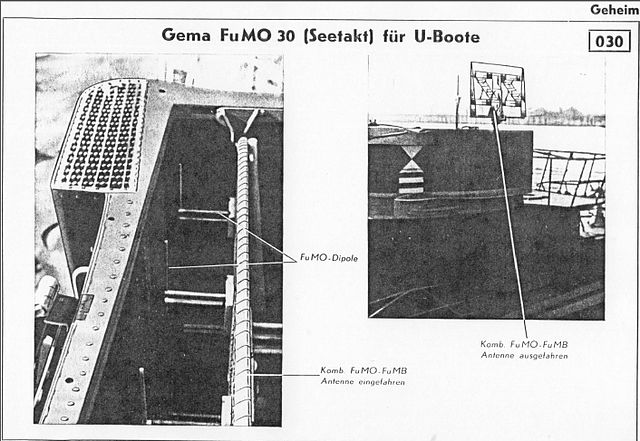
FUMO 30 and Seetakt systems (ONI).
As completed in 1941-1942 the Type XB carried a S-Gerät sonar and a GHG hydrophone, standard for the time. For those of the batches completed 1942-1943, they gained a FuMO 30 radar and FuMB 1 Metox ECM suite in addition. Those released in 1943-44 had the same plus a FuMB 3 Bali and FuMB 6 Palau ECM suites. In 1945 the survivors received the FuMO 61 radar in replacement for the model 30.
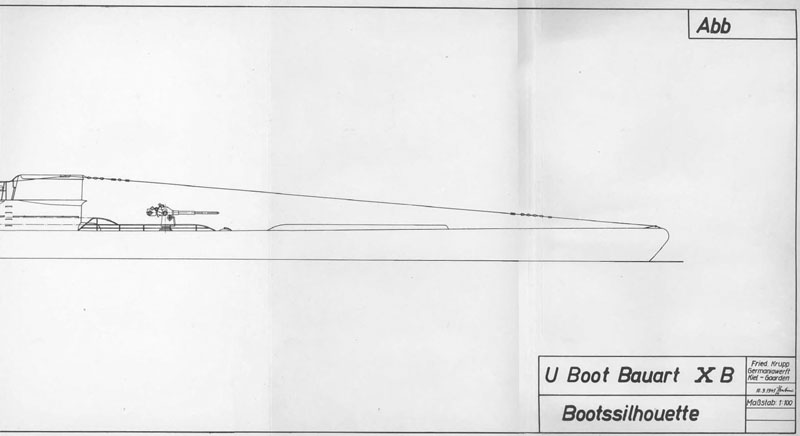
Original plans: Unfortunately only the forward profile survived.

Decks arrangement over view

Internals of the Type XB (src Uboat archives, see notes)
⚙ specifications |
|
| Displacement | 1,763 tonnes surfaced/2,177 tonnes submerged |
| Dimensions | 89.80 m (294 ft 7 in), 9.20 m (30 ft 2 in) wide draught 4.71 m (15 ft 5 in) |
| Propulsion | 2× diesels, 4,700 bhp, 2× AEG electric motors 1,100 PS |
| Speed | 17 kts/7 kts surface/sub. |
| Range | 18,450 nautical miles (34,170 km; 21,230 mi)/10 kts |
| Armament | 1x 10.5 cm deck gun, 2× 21 in stern TTs 15 Torps. 66 × SMA mines |
| Crush depht | Calculated crush depth: 220 m (720 ft) |
| Crew | 5 officers, 47 enlisted |
The alternative design: Type VIID
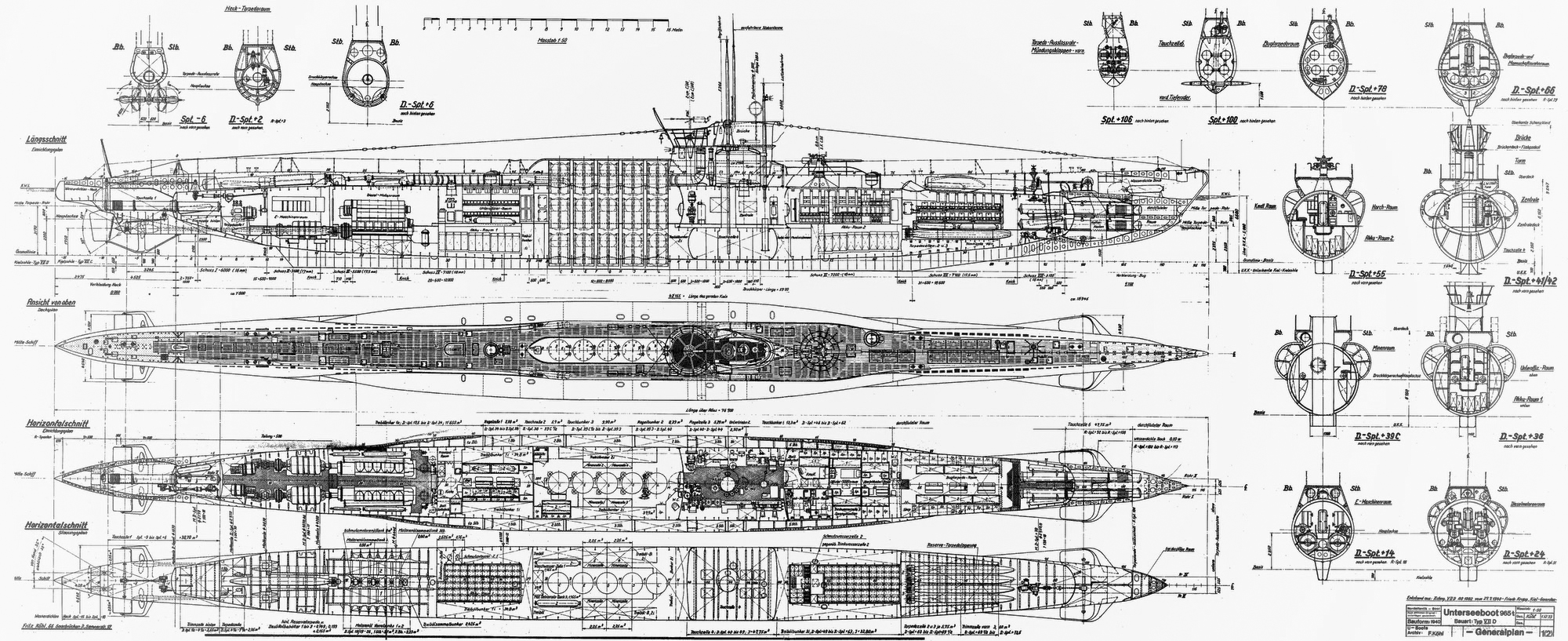
The only other class in service with the Kriegsmarine was a modified Type VII (the great U-Boat standard), completely stretched and modified as the very center of the boat, aft of the conning tower, housed 15 SMA Mines, same type as the XB, but unlike the latter, they were housed in five wells aft of the conning tower, each tall enough to house three mines each, so fifteen in all. The rest of the submersible remained essentially a late improved Type VIIC/42.
Som thoughts were also given to port such conversion to the Type larger Type IXD, but this never was implemented.
And there was the ex-HMS Seal, captured in the Skagerrak and renamed “UB” to distinguish itself from the previous “UA” ex-Batiray.
Assessment of the XB type
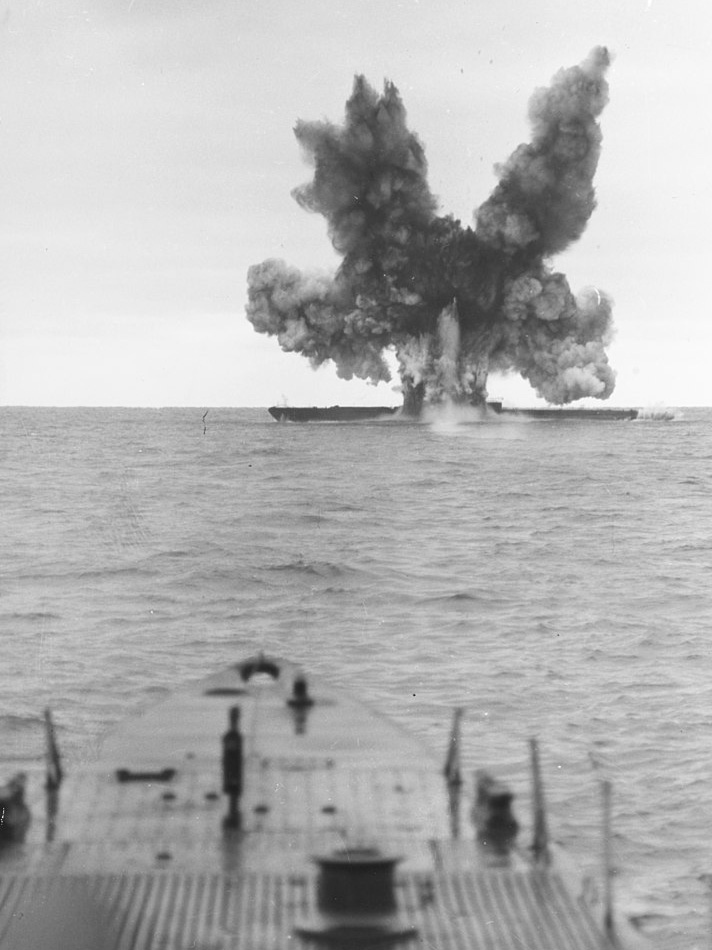
U-234 torpedoed after the war by USS Greenfish. A captured, war prize, she was tested throughly before.
Six of the eight boats built were sunk during the war (four with all hands) but two survived World War II. One survivor was U-234, which surrendered to US Navy ships on 14 May 1945 while en route for Japan with a cargo that included 560 kg uranium oxide, two Me 262 jet fighters, and 10 jet engines.
The other type XB to survive was U-219 which reached Batavia (present-day Jakarta) in December 1944 with a cargo including dismantled V-2 rockets for Japan. Following Germany’s surrender, U-219 was seized by the Japanese at Batavia on 8 May 1945 and on 15 July 1945 was placed into service with the Imperial Japanese Navy as I-505.
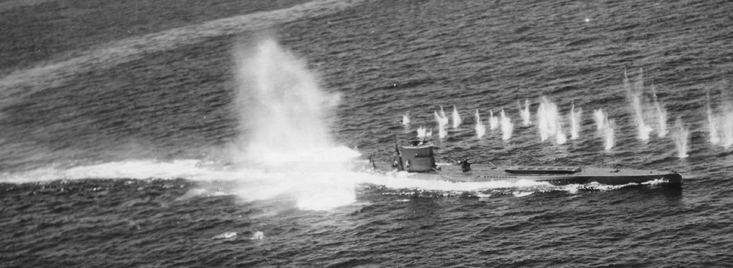
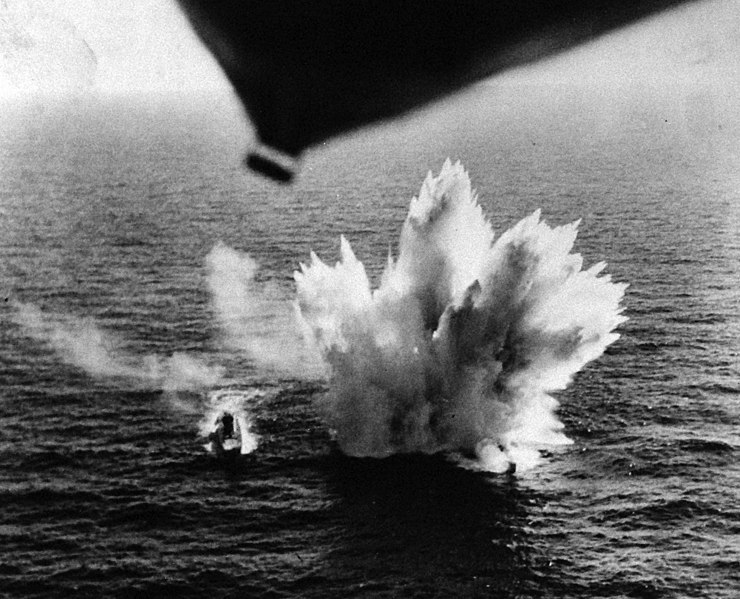
Read More
Books
Conway’s all the worlds fighting ships 1921-1947
Campbell, John Naval Weapons of World War Two
Williamson & Palmer 2002
Gröner, Erich; Jung, Dieter; Maass, Martin (1991). U-boats and Mine Warfare Vessels. Vol. 2. Conway
Williamson, Gordon; Palmer, Ian (2002). Kriegsmarine U-boats 1939-45: Vol 2. Osprey Publishing
Links
U-Boat archive, – Kriegsmarine full manual
on uboat.net
U116 on ubootarchiv.de
Type_X_submarine wiki
on forum.axishistory.com/
UA on ubootarchiv.de/
Batiray on dasboot.forumactif.com/
kbismarck.com kriegsmarine-organization
Model Kits
Neptun 1072 German Submarine U 234 Type XB 1942 1/1250 Scale Model Ship.
 U-116
U-116
(no photo)
U-116 was the lead boat for the class. She was Commissioned on 26 July 1941 and after a quick workout after trials and single training cruise as part og the 2nd Uboat flotilla, she was declared ready for service and departed for her first wartime cruise.
1st patrol:
U-116 was assigned to to the 1st U-boat Flotilla on 1 February 1942. She departed Kiel on 4 April 1942 for Bergen, Norway via Heligoland. Departing Bergen on 25 April, she made the dangerous touor of British Isles before arriving at Lorient, occupied France, on 5 May. She spotted neither attack any ship.
2nd patrol U-116 sailed from Lorient on 16 May 1942 in a mid-Atlantic patrol for 25 days, and back on 9 June. No results.
3rd patrol: U-116 was ordered to the less protected coast of West Africa. She attacked Convoy OS-33 (south of the Azores) on 12 July 1942. Using the usual tactic and penetrating the convoy by night, she fired one torpedo at the 7,093 GRT merchant Cortona, damaged but not sunk. She was finished off by U-201. 9 hours after, she fired her two stern torpedoes on the 4,284 GRT British merchant Shaftesbury, sinking in 15 minutes. She was back at Lorient on 23 August (58 days cruise).
4th patrol: For her last patrol, with a new captain, Oberleutnant zur See Wilhelm Grimme she left Lorient on 22 September 1942, but was reported missing in action. Her last message was dated bacl 6 October in the North Atlantic. Her fate is unknown (likely she was sunk by escorts, but unconfirmed on the allied side), and disappeared with 56 men aboard.
 U-117
U-117
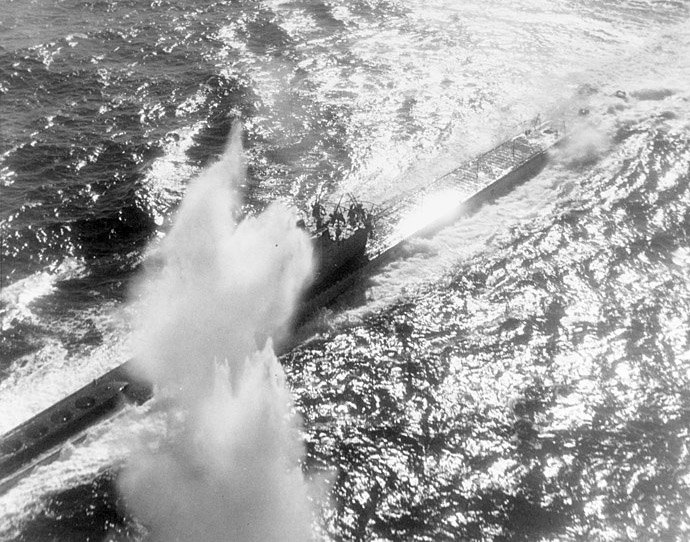
U-117 under attack by US Navy aircraft in the Atlantic, 7 August 1943
U-117 was commissioned on 25 October 1941, much later than her sister U-116, and thus was only operational from mid-1942.
1st Patrol:
On 19 September 1942, she left Kiel for the North Atlantic and along the coast of Norway, then Iceland. She made the great circle back to Lorient in France via the Bay of Biscaye. U-117 she made no encounter during this patrol.
Second patrol: Apparetntly she came back from lorient to Germany (same trip at the reverse) as she departed from Königsberg on 12 October 1942 to Iceland and to the Bay of Biscay, then Lorient on 22 November 1942, mmaking no encounter.
Third patrol:
U-117’s started from Lorient on 23 December 1942, but she encountered no Allied vessels. She was back to her homeport on 3 February 1943.
Fourth patrol:
Departing Lorient on 31 March 1943 for Mid-Atlantic, she headed south to the Canary Islands and from there, French Morocco. On 11 April 1943, she laid a minefield in the usual paths of entry and exit of the Mediterranean to the Atlantic. Her minefield claimed the Matt W. Ransom (damaged). On 25 April 1943, she also claimed SS Empire Morn. The latter was so damage she was later declared a total constructive loss.
Fifth patrol:
On 1 December 1942, U-117 was reassigned to the 12th U-boat Flotilla based in Bordeaux, operating with Italian submarines. She departed Bordeaux on 22 July 1943 with the mission to lay 66 mines off New York City, the very mission they had been designed for in the first place. On 27 July, she was redirected to refuel U-66 also heading for North America. But the latter was attacked before they met by aviation on 3 August, and upon arrival, U-117 provided medical assistance on 6 August.
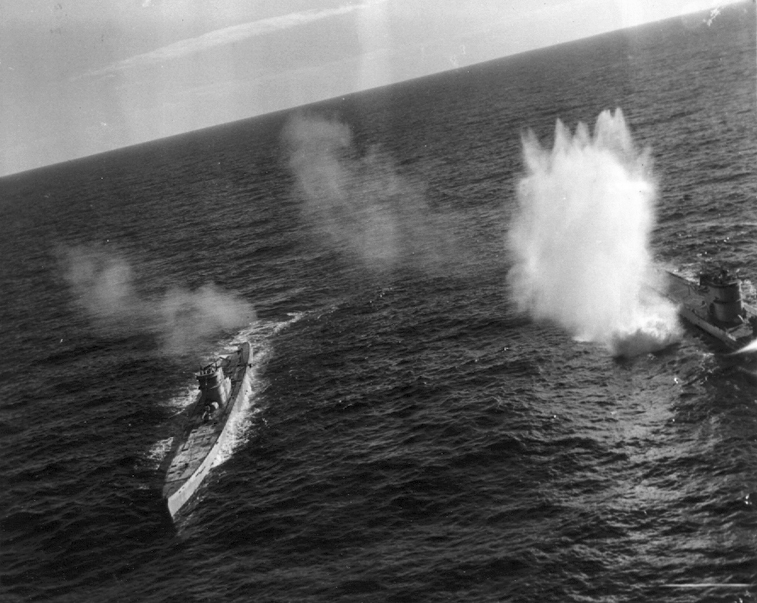
The attack of 8 August 1942 from USS Card. This was one of the earliest success of the Avenger’s new FIDO ASW homing torpedo.
However on the 7th, a several Grumman TBF Avengers from VC-1 USN, USS Card spotted and attacked the two U-boats caught on the surface while U-117 was refueling U-66. Depth charges fell between them, and U-117 was hit by a FIDO homing torpedo. Two more Avengers and two F4F Wildcats coming in a second wave from USS Card forced U-117 to dive and rained depth charges. She was hit by at least one FIDO homing torpedoe and sank with all hands but U-66 escaped back to Lorient.
 U-118
U-118
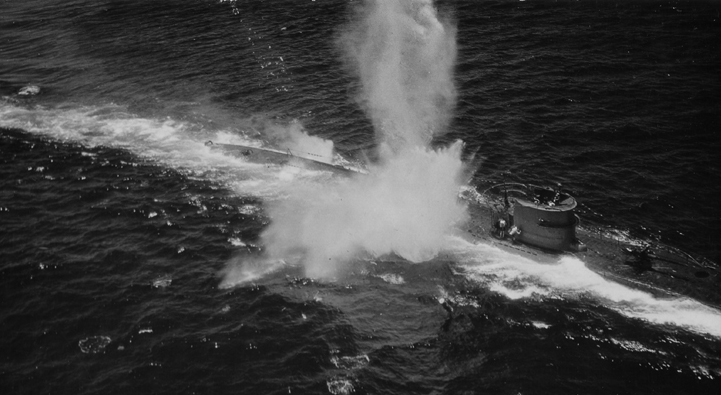
U-118 under attack by USS Bogue’s plane in 1943
U-118 was first commissoned on 23 September 1941 (she was later repaired and recommissioned on 6 December 1941). She tained with the 2nd flotilla.
First patrol
U-118 departed Kiel on 19 September 1942 bound for the North Sea, and well-knopn “Faroe Gap” to enter the Atlantic Ocean. While south of Iceland she was spotted and attacked on 29 September but damage was moderate. She reached Lorient on 16 October and spent some time in repairs.
Second patrol
She departed Lorient to take position between the Azores and Madeira. But after a week she made no spotting and transited from Lorient to Brest on 12-13 December.
Third patrol
Departing Brest on 25 January 1943 she reached Gibraltar via the Bay of Biscaye and Spanish coast. Taking position close to the strait, she spotted and sank Baltonia, Empire Mordred and Mary Slessor on 7 February alone, and lating her minefield the 1st. It claimed Duero the 10th (damaged). The same minefield claimed HMCS Weyburn on 22 February (sunk), the first warship kill of the entire class so far. Apparently her depth charge primers detonated, blasting her and damaging a nearby destroyer coming in assistance. U-118 returned to Bordeaux on 26 February.
Fourth patrol
U-118 was attacked underway off the Canary Islands by two aircraft. Her position was signalled and soon was followed by a wave of eight planes from USS Bogue. She was strafed with .50″ and .30″ ammunition and bombed. One made a direct hit and she split in tow, exploding with oil and debris projected far away. 16 men however survived, later picked up by the escort USS Osmond Ingram.
 U-119
U-119
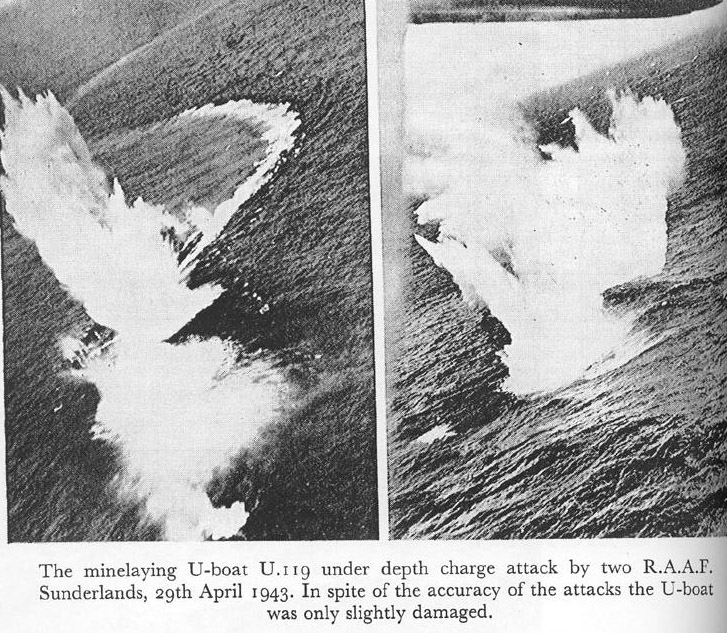
(no pic) U-119 was commissioned on 2 April 1942. After training and workout in the Baltic she was declared ready for operation in the summer, under command of Kapitänleutnant Alois Zech on 2 April 1942, and later Horst-Tessen von Kameke from 15 April 1943. After training with the 4th U-boat Flotilla from April 1942, she really was declared only operational on 1 February 1943 and was transferred to the 12th flotilla.
After a short run from Kiel to Frederikshaven (Denmark) and back on 4 to 10 August 1942 she was declared fit for wartime action and prepared for her first patrol, from Kiel, departing on 6 February 1943 and crossing the North Sea, making the great circle off the northern coast of Iceland, down to Mid-Atlantic, the Bay of Biscay and her forward operating based at Bordeaux, arrivong on 1st April. She was unsuccessfully attacked on 29 April 1943 by a Short Sunderland (461 Squadron RAAF), having one man was killed on deck.
On 1 June she laid a minefield. On 3 June she managed to sink Halma (2,937 GRT), east of Halifax, Nova Scotia. She also damaged John A. Poor (7,176 GRT) on 27 July and both vessel hit mines but the second survived.
The end: U-119 was sunk 24 June 1943 in the Bay of Biscay, north-west of Cape Ortegal, Spain, while she was coming back from her mission to the Gironde estuary. She was spotted surfaced, then depht-charged and eventually fired on, and rammed by the British sloop HMS Starling, sinking with all hands.
 U-219
U-219
(no pic) U-219 was commisioned on 12 December 1942. Training and workout went on until later the next, and she was really operational in late 1943 under command of Korvettenkapitän Walter Burghagen. She had one of the most interesting career of these boats.
First patrol:
U-219 was sent to the South Atlantic with the second “Monsun Gruppe“, navigating to the Indian Ocean, after rounding the British Isles and west of Ireland. They took the long crossing voyage via the south atlantic, West Coast of Africa and rounding the cape until eventually reaching Penang. This U-boat group was attached to 33rd U-boat Flotilla (U-848, U-849, U-850, U-177, and U-510).
U-219 was to lay mines off Cape Town and Colombo. However the group’s U-tanker was destroyed and U-219 was requested to refuel other submarines to return to Germany. U-510 however made it to Penang. U-219 arrived in France and was prepared for a transport mission, operating from Bordeaux.
Second patrol
U-219 left Bordeaux on 23 August 1944 with U-195 and U-180, all heavily loaded with two Japanese officers aboard as translators and observers, and a precious strategic cargo: Uranium oxide for the Japanese nuclear program, blueprints for advanced tech and weapons, twelve dismantled V-2 rockets (in part aboard U-195). While underway, they spent most of their time surfaced and of course were attacked in a single dau five times on 28 September by three Grumman Avengers from USS Tripoli west-southwest of Cape Verde but their FLAK combined managed to shot down one of these. This was the only serious attack of the trip, which concluded successfully when both U-Boats reached reached Japan-occupied Batavia (Jakarta) in December 1944.
In Japanese service
U-219 was prepared to sail back to Germany with some precious materials helping the German industry. However in May 1945 she still had not yet departed. With Germany’s surrender, U-219 was seized by the Japanese at Batavia, on 5 May. On 15 July after some modifications and the help of the German crew, which part remained, she became the Imperial Japanese Navy’s I-505. I-505 career was short however as she was captured at Surabaya in August 1945 by the Royal Navy. She practically had no time to make any war patrol. The British inspected her throughly and made some tests. After being mothballed for a few weeks it was decided to finish her off as a target. She was expended on 3 February 1946 by gunfire and depth charges from the Dutch destroyer HNLMS Kortenaer off the Sunda Strait.
 U-220
U-220
(no pic)
First and last Patrol
U-220 was commissioned on 27 March 1943, with Oberleutnant zur See Bruno Barber in command. She start training in the 4th U-boat Flotilla and later the 12th flotilla when ready for operations.
Following her departure from Kiel, to Bergen she was patrolling on 8 September 1943 in the Faroe Gap (between Iceland and Faroe Islands) with a final destination being the North American coast. Off St. Johns, Canada, she laid 66 magnetic mines (9 October). This minefield later claimed the US merchantman Delisle (3,478 GRT) on the 19th and the same day the British Penolver (3,721 GRT) the very same day, on the 19th. While underway south in the Atlantic, U-220 was spotted and attacked by planes from USS Block Island. Soon, a wave of Avenger and Wildcat came out the same 28 October 1943 to finish her off with bombs, DCs and gunfire. After a direct hit, she was lost with all hands.
 U-233
U-233
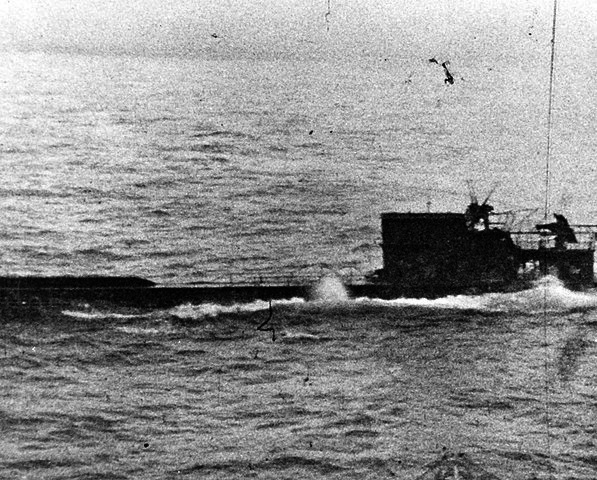
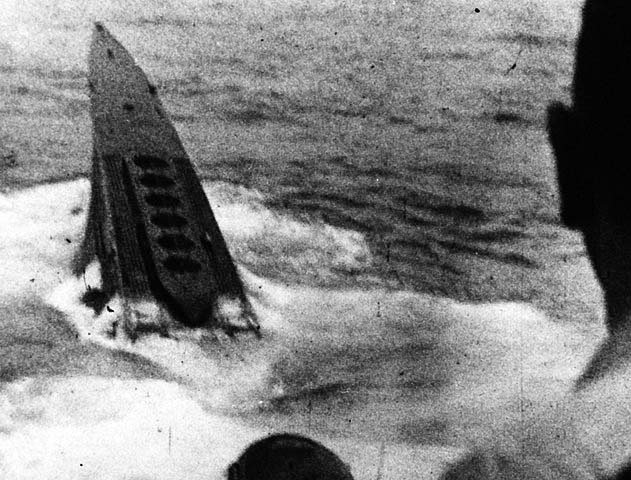
U-233 was commissioned on 22 September 1943 and made ready for operations under command of Oberleutnant zur See Hans Steen. She was assigned to the 4th U-boat Flotilla for training and for advanced training and operaions with the 12th U-boat Flotilla (1 June 1944). Her first and only war patrol started the day she departed Kiel on 27 May 1944. Like her sister U-233 her mission was to lay mines off Halifax. But she never made it there.
On 5 July 1944, U-233 she was caught by USS Card’s (CVE-11) hunter-killer group. At first spotted by sonar, she was depth-charged to the surface and fired on by USS Baker (DE-190), and finished off by ramming, sunk by USS Thomas (DE-102). 32 went with her to the bottom but 29 were rescued by the escorts.
 U-234
U-234
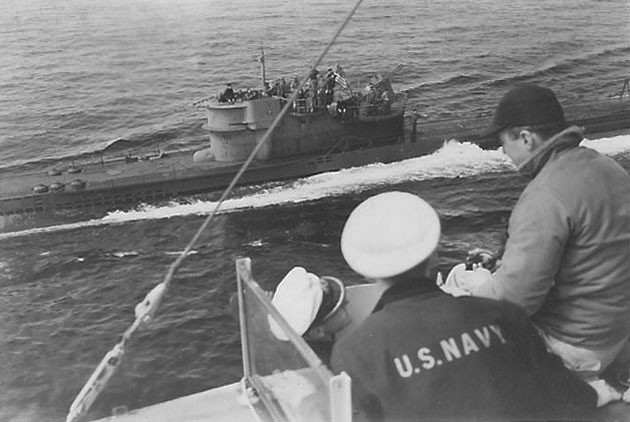
U-234 was damaged during construction (RAF raid), but she was launched on 23 December 1943, but during her completion iot was decided to not use her as minelayer but transport sub right off the bast. Her mission would be to bring to Japan strategic assets.
The most secret U-Boat mission of WW2
She was relocated in Germaniawerft yard, Kiel for reconstruction as transport by 5 September 1944, and had a snorkel added. 12 of her 30 mineshafts receiced special cargo containers fit for them, and held in place by the mine release mechanism. Her standard keel load was replaced by extra cargo, first planned to be optical-grade glass and mercury while her upper-deck torpedo storage compartments on each side received extra cargo containers. She would have the most interesting career of U-Boats.
It’s the special commission “Marine Sonderdienst Ausland” which determined the exact nature of her caro by late 1944, and officers were informed of their mission Japan, which when complete brough her to have 240 tons of cargo, and all the fuel fuel and provisions to make a nearly 9-month (epic) voyage.
U-234 carried not only mercury and rare materials, but mostlt critical intel documentation, engineering plans, blueprints, and parts of the most advanced radars and weapons systems designed by Nazi Germany with a single goal in mind, allow Japan to continue the war. Ampong others she carried the latest German electric hoping torpedoes, an entire Me 262 jet in crate, as well as a Henschel Hs 293 glide bomb (the first antiship missile) and 550 kg (1,210 lb) of uranium oxide for the Japanese nuclear program. In the manifest she was decribed also as carrying “50 lead cubes with 23 centimetres (9.1 in) sides, painted “U-235″” in the cylindrical mine shafts, the “U-powder”.
Cargo and Personal to win the war
U-234 started pos-completion trials near Kiel, and was prepared for the trip and carrying also “VIPs”: The twelve passengers lits including German general Ulrich Kessler (Luftwaffe) with the task of providing help to the Japanese industry to serial built the new aicraft and missiles and ensure liaison with Berlin, four German naval officers, civilian engineers and scientists as well as two Japanese naval officers acting also as translators. Kay Nieschling (a Naval Fleet Judge Advocate) was to try to find a spy in the diplomatic corps in Japan (Richard Sorge ring). Also was aboard Heinz Schlicke, a radar specialist also specialized in infrared systems and radar countermeasures. There was also the director of the Naval Test Fields in Kiel and August Bringewalde, Messerschmitt’s production specialist for the Me 262 production. The Japanese officers were Lt. Cdr Hideo Tomonaga, IJN, and naval architect/submarine designer arrived in Germany back in 1943 on I-29 and Commander Shoji Genzo, aircraft specialist, former naval attaché, also coming back with tons of documentation after his long stay in Germany.
So this was, by all means, a very strategic mission with the potential for Japan to return the fate of arms.
Trials in Norway
U-234 thus departed Kiel for Kristiansand, Norway on the evening of 25 March 1945. At that stage, the U-Boat war was over, air supremacy was total and travelling while surfaced was perilous at best. She was accompanied by escort vessels plus three Type XXIII coastal U-boats until reaching the Horten Naval Base on the 27th. After eight days of trials including testing her snorkel in safe area, she accidentally collided with a Type VIIC U-boat also making her trials in the vicinity. Damage was light, she ws patched and declared ready to undertake her trip to Kristiansand, (5 April) for more repairs, replenished her provisions, fuel and prepared for the
The trip
U-234 departed Kristiansand on 15 April 1945, submerged at snorkel depth for 16 days untik her commander Kapitänleutnant Johann-Heinrich Fehler estimated she passed the “danger zone” and was ready to run surfaced. He also expected to cross a severe storm to hid him out. Captain Fehler soon found the ideal and safest way to travel: Two hours surfaced at the dead of night and the rest submerged with snorkel. However of the tip was without incident, the Goliath tranmitter eventuall fell silent, revealing some clues about what happened back home. The Nauen station followed, as the Kriegsmarine HQ was just captured by the allies.
On 4 May, while surfaced, U-234 received a partial British broadcast and learned later by American radio Admiral that Karl Dönitz was now at the head of the state after the death of Adolf Hitler. U-234 surfaced eventually on 10 May and received Dönitz’s order to all U-boats still in operation, to surface and surrender to any encountered Allied forces. Fehler however sensed a trick and contacted nearby U-873 for confirmation.
U-234 having no more purpose, she could sail either to a British, Canadian or U.S. port and eventually he decided to head for the US east coast, believing United States cuqtody to be less harsh than British or Canadian one, even to be repatriated quickly. He radioed on 12 May his intention to sail to Halifax, Nova Scotia as a ruse, whereas he set sail for Newport News instead, in Virginia. Not willing still to leave valuable assets to the former enemy, he dismounted and thrown overboard his Tunis radar detector, Kurier radio communication system, Enigma machine and documentation as well as any other classified files. Meanwhile informed, the two Japanese passengers decided to commit Seppuku using poison and were buried at sea.
Capture
The radio ruse was eventually found out by US authorities after a spotting and two destroyers arrived to intercept U-234. On 14 May 1945, while off the Grand Banks, Newfoundland Captain Fehler and his officers saw first with their binocular the prow of USS Sutton, steaming at full speed. The sky was pristine blue, with a vibility to dozens of miles. USS Sutton’s crew soon launched a boarding party to discuss the surrender terms and take control of the boat. They were ordered to sail for Portsmouth Naval Shipyard and be interned, joining there U-805, U-873, and U-1228.
News of the “secret U-Boat” immediately became a national sensation, widly relayed by new medias. The press was baffled by her high-ranking German passengers and even before she arrived, journalists crammed into a small boat came for a close look at the submarine. US intelligence was almost immediately at hands with everything of use, starting an inventory. It was done on 19 May. What they listed on were drawings and medical supplies as well as composite steels, instruments, optical glass and materials such as brass, lead, mercury, plus its carefully packed 1,200 pounds (540 kg) of uranium oxide. This load remained classified until the end of the Cold War.
This captured, in the frame of Operation paperclip soon generated an abundant litterature, still ongoing to this day, including radio broadcasts, TV documentaries, and some pseudo-historical and conspirationist works recently. Joseph M. Scalia claimed the uranium was in gold-lined cylinders in his “Hitler’s Terror Weapons”. Carl Boyd and Akihiko Yoshida speculated the uranium was to be used as catalyst for the production of synthetic methanol for aviation fuel, not to be military grade one for the Japanese nuclear program. But it was later discovered that there were cyclotrons in Japan and indeed an atomic bomb program. The Uranium was likely recuperated to be studied and used at the Oak Ridge diffusion plant. It was estimated just 20% of what was necessary to create a fission weapon.
After she was studied, U-234 having no longer purpose was disposed of by the USN: She was torpedoed in exercize by USS Greenfish (Gato class) off Cape Cod, Massachusetts, 20 November 1947.

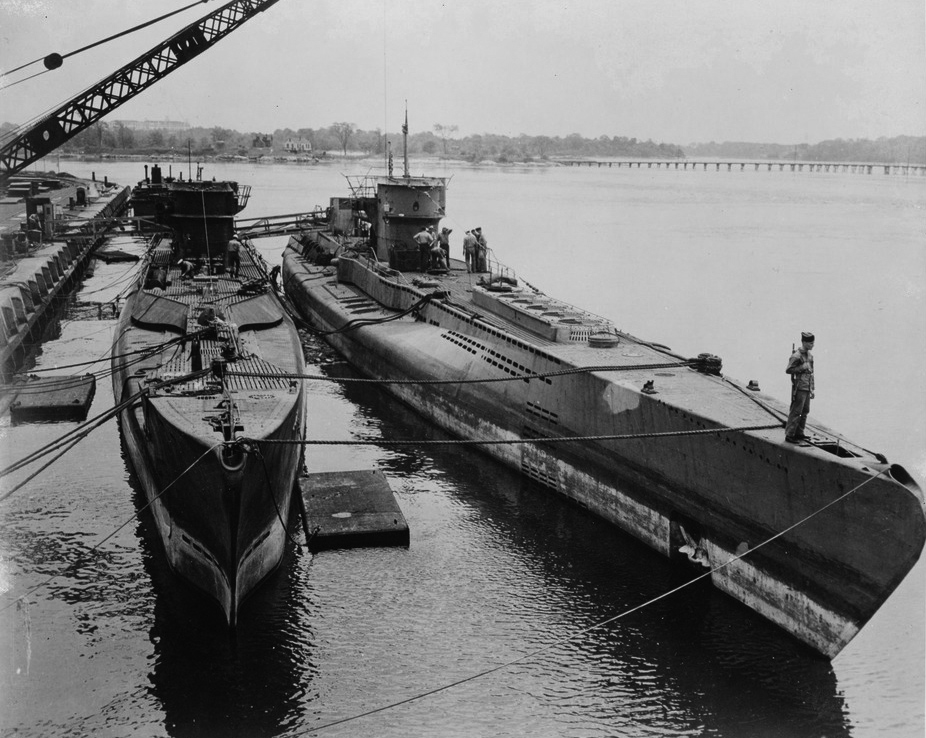
 Latest Facebook Entry -
Latest Facebook Entry -  X(Tweeter) Naval Encyclopedia's deck archive
X(Tweeter) Naval Encyclopedia's deck archive Instagram (@navalencyc)
Instagram (@navalencyc)





 French Navy
French Navy Royal Navy
Royal Navy Russian Navy
Russian Navy Armada Espanola
Armada Espanola Austrian Navy
Austrian Navy K.u.K. Kriegsmarine
K.u.K. Kriegsmarine Dansk Marine
Dansk Marine Nautiko Hellenon
Nautiko Hellenon Koninklije Marine 1870
Koninklije Marine 1870 Marinha do Brasil
Marinha do Brasil Osmanlı Donanması
Osmanlı Donanması Marina Do Peru
Marina Do Peru Marinha do Portugal
Marinha do Portugal Regia Marina 1870
Regia Marina 1870 Nihhon Kaigun 1870
Nihhon Kaigun 1870 Preußische Marine 1870
Preußische Marine 1870 Russkiy Flot 1870
Russkiy Flot 1870 Svenska marinen
Svenska marinen Søværnet
Søværnet Union Navy
Union Navy Confederate Navy
Confederate Navy Armada de Argentina
Armada de Argentina Imperial Chinese Navy
Imperial Chinese Navy Marinha do Portugal
Marinha do Portugal Mexico
Mexico Kaiserliche Marine
Kaiserliche Marine 1898 US Navy
1898 US Navy Sovietskiy Flot
Sovietskiy Flot Royal Canadian Navy
Royal Canadian Navy Royal Australian Navy
Royal Australian Navy RNZN Fleet
RNZN Fleet Chinese Navy 1937
Chinese Navy 1937 Kriegsmarine
Kriegsmarine Chilean Navy
Chilean Navy Danish Navy
Danish Navy Finnish Navy
Finnish Navy Hellenic Navy
Hellenic Navy Polish Navy
Polish Navy Romanian Navy
Romanian Navy Turkish Navy
Turkish Navy Royal Yugoslav Navy
Royal Yugoslav Navy Royal Thai Navy
Royal Thai Navy Minor Navies
Minor Navies Albania
Albania Austria
Austria Belgium
Belgium Columbia
Columbia Costa Rica
Costa Rica Cuba
Cuba Czechoslovakia
Czechoslovakia Dominican Republic
Dominican Republic Haiti
Haiti Hungary
Hungary Honduras
Honduras Estonia
Estonia Iceland
Iceland Eire
Eire Equador
Equador Iran
Iran Iraq
Iraq Latvia
Latvia Liberia
Liberia Lithuania
Lithuania Mandchukuo
Mandchukuo Morocco
Morocco Nicaragua
Nicaragua Persia
Persia San Salvador
San Salvador Sarawak
Sarawak Uruguay
Uruguay Venezuela
Venezuela Zanzibar
Zanzibar Warsaw Pact Navies
Warsaw Pact Navies Bulgaria
Bulgaria Hungary
Hungary

 Bundesmarine
Bundesmarine Dutch Navy
Dutch Navy Hellenic Navy
Hellenic Navy Marina Militare
Marina Militare Yugoslav Navy
Yugoslav Navy Chinese Navy
Chinese Navy Indian Navy
Indian Navy Indonesian Navy
Indonesian Navy JMSDF
JMSDF North Korean Navy
North Korean Navy Pakistani Navy
Pakistani Navy Philippines Navy
Philippines Navy ROKN
ROKN Rep. of Singapore Navy
Rep. of Singapore Navy Taiwanese Navy
Taiwanese Navy IDF Navy
IDF Navy Saudi Navy
Saudi Navy Royal New Zealand Navy
Royal New Zealand Navy Egyptian Navy
Egyptian Navy South African Navy
South African Navy






























 Ukrainian Navy
Ukrainian Navy dbodesign
dbodesign